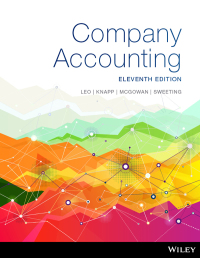Question
Kookie , Inc. receives inventory on Mondays of each week. It makes sales throughout the week, but records sales on a weekly basis on Fridays.
Kookie, Inc. receives inventory on Mondays of each week. It makes sales throughout the week, but records sales on a weekly basis on Fridays. Kookie has a beginning inventory of 4,000 purchased at $5 each. Kookie, Inc.s suppliers do not offer discounts. The following purchases and sales were recorded during March. The selling price is $10 per unit. Operating expenses are $50,000 and the tax rate is 20 percent.
Purchases Sales
March 23,000 units
March 58,000 units at $6
March 97,000 units
March 126,000 units at $7
March 164,000 units
March 195,000 units at $8
March 231,000 units
March 262,000 units at $9
March 309,000 units
Required:
1.Determine the cost of goods sold, net income, and ending inventory using FIFO.
2.Determine the cost of goods sold, net income, and ending inventory using LIFO.
3.Assume that all expenses, inventory purchases, and revenues are paid or received in cash. What is the operating cash flow using FIFO versus LIFO?
Kookie, Inc. receives inventory on Mondays of each week. It makes sales throughout the week, but records sales on weekly basis on Fridays. The following sales were recorded in March. Each unit sells for $12 and all sales are on account.
March 23,000 units sold (cost of goods sold = $24,000)
March 95,000 units sold (cost of goods sold = $40,950)
March 166,000 units sold (cost of goods sold = $50,400)
March 235,500 units sold (cost of goods sold = $47,775)
March 306,500 units sold (cost of goods sold = $57,825)
Required:
1.Make the journal entries to record the above events.
2.Make the journal entry to record the collection of the March 2 sale assuming a 2 percent discount is taken.
3.Make the journal entry to record the collection of the March 9 sale assuming no discount is taken.
4.Make the journal entry to record the return of the March 16 sale.
Hamilton Company shows the following information concerning its net realizable value of accounts receivable.
EndingBeginning
Accounts receivable$750,000$625,000
Allowance for uncollectible accounts 80,000 60,000
During the period, sales were $2,550,000, sales returns and allowances were $35,000, sales discounts were $40,800. The uncollectible accounts expense for the period was $25,000 and $5,000 of accounts were written off as uncollectible.
How much cash was received from customers?

Step by Step Solution
There are 3 Steps involved in it
Step: 1

Get Instant Access to Expert-Tailored Solutions
See step-by-step solutions with expert insights and AI powered tools for academic success
Step: 2

Step: 3

Ace Your Homework with AI
Get the answers you need in no time with our AI-driven, step-by-step assistance
Get Started


